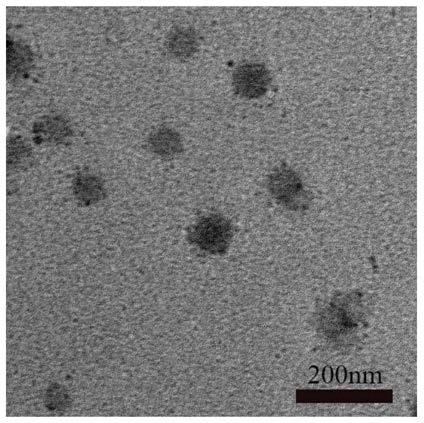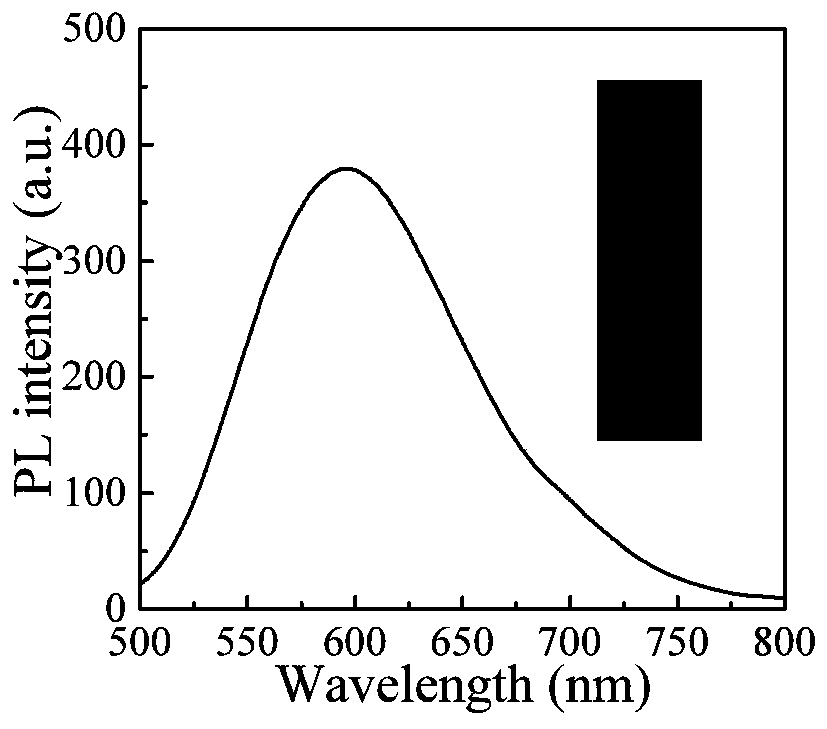Preparation method of amino and polypeptide modified AIE polymer nanoparticles
A nanoparticle and polypeptide modification technology, applied in chemical instruments and methods, luminescent materials, etc., can solve problems such as limited applications
- Summary
- Abstract
- Description
- Claims
- Application Information
AI Technical Summary
Problems solved by technology
Method used
Image
Examples
Embodiment 1
[0083] Weigh 0.2g of O-50 emulsifier and 0.1g of 2-aminoethyl methacrylate hydrochloride, and dissolve them in 12.5g of deionized water to obtain an aqueous phase solution.
[0084] Weigh 0.01g of AIE-6 molecule and dissolve it in a mixed solution of 0.06g of n-hexadecane and 0.9g of methyl methacrylate to obtain an oil phase solution; add the water phase solution to the oil phase solution and pre-emulsify by stirring Finally, a coarse emulsion was obtained; the container containing the coarse emulsion was placed in an ice-water bath, and a stable monomer fine emulsion was obtained by ultrasonication with a power of 400W for 9 minutes; Amidine hydrochloride, the temperature was raised to 65° C., and reacted for 6 hours under the protection of nitrogen to prepare an amino-modified AIE polymer nanoparticle emulsion. With a molecular weight cut-off of 5000g·mol –1 The dialysis bag was dialyzed for three days, and the water change frequency was changed every 2h on the first day, ...
Embodiment 2
[0101] Weigh 0.5 g of Tween 20 and 0.15 g of 2-aminoethyl methacrylate hydrochloride, dissolve them in 15 g of deionized water, and obtain an aqueous phase solution.
[0102] Weigh 0.0075g of AIE-12 molecule and dissolve it in the mixed solution of 0.08g of n-hexadecane and 1.35g of styrene to obtain an oil phase solution; add the water phase solution to the oil phase solution and pre-emulsify it with stirring to obtain Coarse emulsion; place the container containing the coarse emulsion in an ice-water bath, and use an ultrasonic wave with a power of 200W for 20 minutes to obtain a stable monomer fine emulsion; pass nitrogen to remove oxygen, add 0.015g of azobisisobutylamidine hydrochloride salt, the temperature was raised to 60° C., and reacted for 24 hours under the protection of nitrogen to prepare an amino-modified AIE polymer nanoparticle emulsion. With a molecular weight cut-off of 5000g·mol –1The dialysis bag was dialyzed for three days, and the water change frequency...
Embodiment 3
[0108] Weigh 0.3g of MOA-9 and 0.05g of 2-aminoethyl methacrylate hydrochloride, dissolve them in 15g of deionized water, and obtain an aqueous phase solution.
[0109] Weigh 0.05g of AIE-15 molecules and dissolve in a mixed solution of 0.08g n-hexadecane, 0.45g styrene and 0.5g methyl methacrylate to obtain an oil phase solution; add the water phase solution to the oil phase solution , after stirring and pre-emulsifying, a coarse emulsion was obtained; the container containing the coarse emulsion was placed in an ice-water bath, and a stable monomer fine emulsion was obtained by ultrasonication with a power of 600W for 5 minutes; nitrogen and deoxygenation, adding 0.05g Azobisisobutylamidine hydrochloride, the temperature was raised to 65° C., and reacted for 3 hours under the protection of nitrogen to prepare an amino-modified AIE polymer nanoparticle emulsion. With a molecular weight cut-off of 5000g·mol –1 The dialysis bag was dialyzed for three days, and the water change...
PUM
| Property | Measurement | Unit |
|---|---|---|
| emission peak | aaaaa | aaaaa |
| particle size | aaaaa | aaaaa |
| particle size | aaaaa | aaaaa |
Abstract
Description
Claims
Application Information
 Login to View More
Login to View More - R&D
- Intellectual Property
- Life Sciences
- Materials
- Tech Scout
- Unparalleled Data Quality
- Higher Quality Content
- 60% Fewer Hallucinations
Browse by: Latest US Patents, China's latest patents, Technical Efficacy Thesaurus, Application Domain, Technology Topic, Popular Technical Reports.
© 2025 PatSnap. All rights reserved.Legal|Privacy policy|Modern Slavery Act Transparency Statement|Sitemap|About US| Contact US: help@patsnap.com



